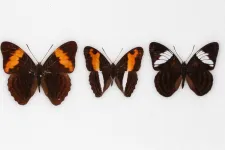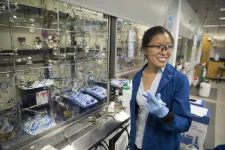(Press-News.org) CHAMPAIGN, Ill. -- The chronic stress of living in neighborhoods with high rates of violence and poverty alters gene activity in immune cells, according to a new study of low-income single Black mothers on the South Side of Chicago.
The changes in stress-related gene expression reflect the body's "hunker down" response to long-term threat, a physiological strategy for lying low and considering new actions rather than launching an immediate "fight-or-flight" response. This has implications for health outcomes in communities of color and other marginalized populations, said researchers at the University of Illinois Urbana-Champaign and collaborators at the University of Kentucky and UCLA. The researchers published the study in the journal Psychoneuroendocrinology.
"The question we asked is, how does stress get under the skin to affect health and wellness? We wanted to hear the stories of low-income single Black mothers on the South Side of Chicago and really try to understand what it's like to live in neighborhoods with high levels of violence and how it affects these women," said study leader Ruby Mendenhall, an Illinois professor of African American studies and of sociology, and the assistant dean for diversity and democratization of health innovation at the Carle Illinois College of Medicine.
Mendenhall's group surveyed 68 women from high-violence neighborhoods. They shared stories, filled out stress assessments and gave blood samples.
From the women's accounts and surveys, as well as from police records of violent crime, the researchers measured levels of stress related to racism, poverty and neighborhood violence.
Then, the researchers studied how genes related to stress and immunity were expressed in white blood cells, called leukocytes, found in the participants' blood samples.
"Leukocytes are part of the immune system. They become activated to help fight disease and infection, and also respond to certain stress hormones, and that means their genes are good indicators for the effects of stress on health and well-being," said study co-author Gene Robinson, an entomology professor and the director of the Carl R. Woese Institute for Genomic Biology and interim dean of the College of Liberal Arts and Sciences at the U. of I.
When looking at genes associated with a flight-or-flight stress pathway, the researchers saw no significant differences between participants who perceived their neighborhoods as dangerous and those who did not. However, they found that women who reported greater neighborhood danger showed significantly greater activity of genes regulated by the glucocorticoid receptor - a stress-response pathway that previously has been documented in animals' hunker-down response to persistent, overwhelming threat, said study co-author Steve Cole, a professor at UCLA.
"These hunker-down responses are the body's strategy for conserving resources and persevering in the face of overwhelming adversity," Cole said. "Instead of preparing to fight or flee, the body bides its time and preserves itself for better days in the future. But it's important to get to that better future, or the hunkered-down body may not do the ongoing maintenance work needed for optimal health."
The distinction between the two stress pathways is important for planning health interventions and improving health outcomes, said study co-author Clare Rittschof, a professor at the University of Kentucky and former postdoctoral researcher in Robinson's group.
"Increased glucocorticoid activity is typically associated with aging, so it's as if these women are showing signs of accelerated aging, which is thought to be one reason that stress can lead to worse health outcomes," Rittschof said.
Next, the researchers are exploring the cultural coping mechanisms the Black women in the study community rely on in their daily lives, as well as training health care and social services providers and policymakers on ways to decrease stress, improve health outcomes, decrease disparities and foster health equity.
"These efforts must be coupled with policies broadly aimed to eliminate structural racism in our society, a big source of stress for African Americans," the authors said in a joint statement. "This is consistent with medical schools around the country declaring racism as a health crisis, including the Carle Illinois College of Medicine."
INFORMATION:
Illinois graduate student Meggan Lee, Illinois professors Andrew Greenlee and Sandra Rodriguez-Zas, and Vanderbilt University professor Kedir Turi were co-authors of the paper. The University of Illinois Urbana-Champaign, the Richard and Margaret Romano Professorial Scholarship and the USC/UCLA Center on Biodemography and Population Health supported this work.
Editor's notes: To reach Ruby Mendenhall, email rubymen@illinois.edu. To reach Gene Robinson, email generobi@illinois.edu. To reach Clare Rittschof, email clare.rittschof@uky.edu.
The paper "Transcriptomic analyses of black women in neighborhoods with high levels of violence" is available online.
GAINESVILLE, Fla. --- The showy colors of some butterflies could advertise their speed and nimbleness, much like a coat of bright yellow paint on a sports car. A new study shows birds can learn to recognize these visual cues, avoiding not only butterflies they've failed to nab in the past but similar-looking species as well.
The research provides some of the strongest evidence to date for the idea of evasive mimicry, a strategy in which animals protect themselves from predators by matching the colors or patterns of agile relatives. First proposed more than 60 years ago, the hypothesis has been a challenge to test.
But in an experimental setting, ...
SAN ANTONIO -- Surgically opening the windpipe, or trachea, within the first seven days of the start of mechanical ventilation decreases the time patients spend on ventilators, shortens their ICU stay and lowers their risk of ventilator-associated pneumonia, according to a systematic review published Thursday (March 11) in JAMA Otolaryngology-Head & Neck Surgery.
"We analyzed the existing medical literature to unravel a question that is very pertinent to adult critical care," said senior author Alvaro Moreira, MD, MSc, of The University of Texas Health Science Center at San Antonio (UT Health San ...
The global battle against antibiotic resistance can only succeed if local contexts are taken into account. "A tailored approach is needed in each country," says Heiman Wertheim of Radboud university medical center. "There is no "one-size-fits-all' solution." This was the main finding of a study on antibiotic resistance in African and Asian countries funded by the British Wellcome Trust. Wertheim is the lead investigator of a large group of international researchers who recently published an article on this study in The Lancet Global Health.
Antibiotics are powerful treatments for bacterial infections. They are indispensable for controlling infections such as pneumonia, meningitis, or blood poisoning (sepsis) caused by bacteria. But they are ineffective for treating ...
Sugar has been called "evil," "toxic," and "poison." But the body needs sugars, too. Sugar molecules help cells recognize and fight viruses and bacteria, shuttle proteins from cell to cell, and make sure those proteins function. Too much or too little can contribute to a range of maladies, including neurodegenerative diseases like Alzheimer's, inflammation, diabetes, and even cancer.
About 85 percent of proteins, including those associated with Alzheimer's and Parkinson's, are beyond the reach of current drugs. One critical and abundant sugar (O-GlcNAc, pronounced o-glick-nack) is found on over 5,000 proteins, often those considered "undruggable." But now, researchers at Harvard University ...
Boston, MA - Vaccinating adults age 26 and older against the human papillomavirus (HPV)--the virus that causes more than 90% of cervical cancers as well as several other cancers--may not be cost-effective, according to a new study led by researchers at the Harvard T.H. School of Public Health.
"Our study found that the added health benefit of increasing the vaccination age limit beyond 26 years is minimal, and that the cost-effectiveness is much lower than in pre-adolescents, the target age group for the HPV vaccine," said Jane Kim, K.T. Li Professor of Health Economics and lead author of the study.
The study will be published March 11, 2021, in PLOS Medicine.
HPV vaccines have been shown to be highly effective in preventing ...
Eating is a dangerous business. Naturally occurring toxins in food and potentially harmful foodborne microbes can do a number on our intestines, leading to repeated minor injuries. In healthy people, such damage typically heals in a day or two. But in people with Crohn's disease, the wounds fester, causing abdominal pain, bleeding, diarrhea and other unpleasant symptoms.
Researchers at Washington University School of Medicine in St. Louis and the Cleveland Clinic have discovered that a fungus found in foods such as cheese and processed meats can infect sites of intestinal damage in mice and people with Crohn's and prevent healing. Moreover, treating infected mice with antifungal medication eliminates the fungus and allows the wounds ...
Insights into how bacterial proteins work as a network to take control of our cells could help predict infection outcomes and develop new treatments.
Much like a hacker seizes control of a company's software to cause chaos, disease-causing bacteria, such as E. coli and Salmonella, use miniature molecular syringes to inject their own chaos-inducing agents (called effectors) into the cells that keep our guts healthy.
These effectors take control of our cells, overwhelming their defences and blocking key immune responses, allowing the infection to take hold.
Previously, studies have investigated single effectors. Now a team led by scientists at Imperial College London and The Institute of Cancer ...
A team led by Christoph Utschick and Prof. Rudolf Gross, physicists at the Technical University of Munich (TUM), has developed a coil with superconducting wires capable of transmitting power in the range of more than five kilowatts contactless and with only small losses. The wide field of conceivable applications include autonomous industrial robots, medical equipment, vehicles and even aircraft.
Contactless power transmission has already established itself as a key technology when it comes to charging small devices such as mobile telephones and electric toothbrushes. Users would also like to see contactless charging made available for larger electric machines such as industrial robots, medical equipment and electric vehicles.
Such devices could ...
How do you turn "dumb" headphones into smart ones? Rutgers engineers have invented a cheap and easy way by transforming headphones into sensors that can be plugged into smartphones, identify their users, monitor their heart rates and perform other services.
Their invention, called END ...
Irvine, Calif., March 11, 2021 - Catastrophic collapse of materials and structures is the inevitable consequence of a chain reaction of locally confined damage - from solid ceramics that snap after the development of a small crack to metal space trusses that give way after the warping of a single strut.
In a study published this week in Advanced Materials, engineers at the University of California, Irvine and the Georgia Institute of Technology describe the creation of a new class of mechanical metamaterials that delocalize deformations to prevent failure. They did so by turning to tensegrity, a century-old design principle in which isolated ...





